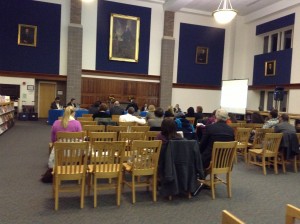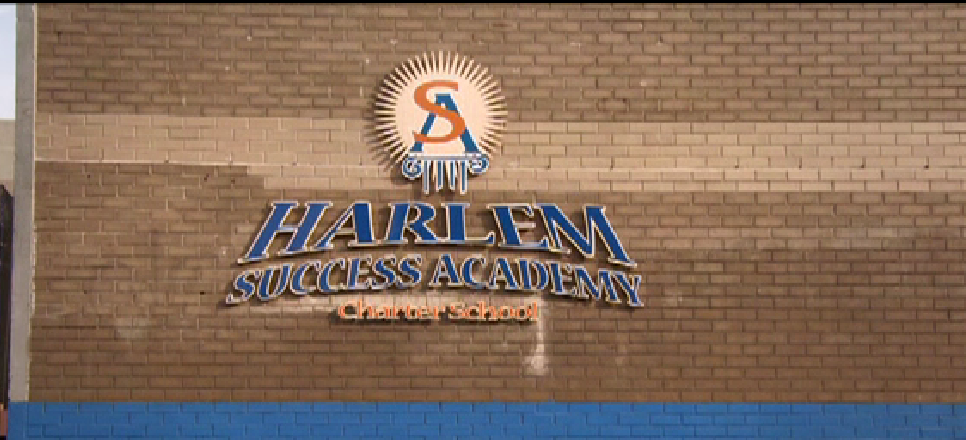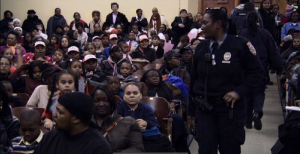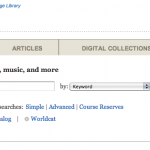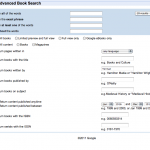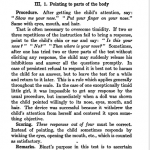As education reformers think of ways to solve the problems that plague the education system there is a growing interest in studying the crisis that affects the teaching profession. A report issued by the National Commission on Teaching and America’s Future in 2003 states, “the nation has reached a consensus that well-prepared teachers are the most valuable resource a community can provide to its young people (Hunt and Carroll 4).” The number of college students that were interested in teacher education in the 1980s and 1990s plummeted. This brought a new challenge for states across the U.S to provide more ways for people to enter the field. The solution proposed was the creation of alternative certification programs, which was embraced by few states including New Jersey early on (Grossman and Loeb 3). This new approach provided opportunities to greatly increase the number of people in the field and a “fast track” learning experience to get them in schools quicker.
In more recent years, reformers have seen negative consequences resulting from alternative certification programs. Issues of teacher shortages have evolved to issues of high teacher turnover rates of the large number of people who enter the field especially in urban and high-needs schools. There are also questions of teacher quality and the reputation of professionalism for the teaching profession as a whole. The reauthorization of the Higher Education Opportunity Act in 2008 supports the creation and sustainment of a new pathway to teaching. This new pathway will provide extended pre-service training in which theory and classroom practice are interwoven, mentoring opportunities for prospective teachers from more experienced teachers, and will allow prospective teachers to experience the environments they will work in before they take on their on classrooms (Higher Education Act). Programs in urban cities like Chicago and Boston have provided the blueprint for this model for teacher preparation. This essay aims to address how the Urban Teacher Residency concept arose as an improved alternative for teaching in the early 2000s, and what implications it has on the future of education.
Urban Teacher Residency programs (UTRs) were created to provide professional development and support to reduce the high turnover rate of new teachers in urban schools and better prepare them for the field. Traditional and fast track teacher certification programs do not provide enough support for novice teachers because they lack a sufficient amount of pre-service experiences for teacher candidates in classrooms. UTR teacher trainees commit to four to five years in the program. During the first year, the teacher trainees have the opportunity to get a Master’s level degree in their subject of choice while gaining experience in the classroom by shadowing a veteran teacher who serves as a mentor. After completing the first year, the teachers commit to teaching three or four years (which depends on requirements of the district they are serving) and are placed in their own classroom in high-needs school districts in urban areas. They receive support throughout the remainder of the program to ensure that they provide quality instruction and remain in the field. Contrary to popular belief this is not a new concept, but instead a variation of a teacher preparation model that was introduced in the 1980s when reformers were thinking of way to solve the teacher crisis of the time.
Revisiting the Past: Professional Development Schools
The Urban Teacher Residency concept evolved from professional development schools, which were an experiment that teacher education reformers were trying in the 1980s. Professional development schools (PDS) also known as “clinical schools” were jointly operated by universities and school districts and were structured to provide new teachers more practice based experiences in schools, and refine the teaching and leadership skills of veteran teachers (Olson). This change would in turn improve student learning and achievement. During this time teaching was not a valued profession because of the training and pay rates in comparison to doctors and lawyers during the time. This model was based on the medical school residency and would serve as a ladder for teachers to climb. The logic was simple: the more opportunities that novice teachers had to prepare for the field the better they would perform. Furthermore, it would allow them to move up in the ranks by taking on leadership roles such as being a mentor.
In 1986, two national reports were released that called for reform in teacher preparation. The Carnegie Forum on Education and the Economy released “A Nation Prepared: Teachers for the 21st Century” and The Holmes Groups released “Tomorrow’s Teachers.” Both reports called for a restructuring of the teacher education that existed during the time. A Nation Prepared stated that the restructuring process begins with establishing higher standards for teacher education. One solution proposed was the elimination of the undergraduate degree in education.
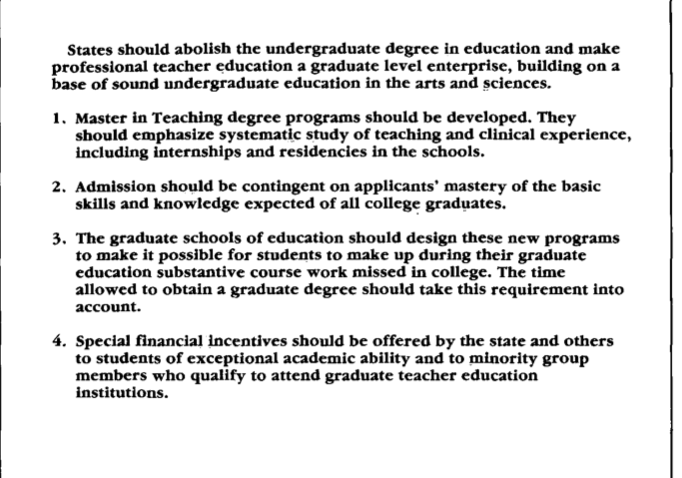
There was a growing concern of the large number of prospective teachers who failed exams that tested skills such as reading comprehension (Carnegie Forum on Education and the Economy). Although teachers were required to hold at least a bachelor’s degree to teach, the lack of academically challenging classes had many people perceive the profession as worthless. The Carnegie Forum felt that undergraduate training should be used to ground future educators in the subjects that they would teach leaving graduate level coursework on teaching theories, practices, and in the field training. The release of the two reports was a turning point in teacher education and the education field as a whole.
As Times and Ideas Change Things Remain the Same
In 2003, experienced teachers Vivian Troen and Katherine Boles published a book titled “ Who’s Teaching Your Children?” Their book addressed the crisis and offered similar solutions 17 years after the release of the A Nation Prepared and The Holmes Group reports. Troen and Boles constructed the idea that is known as the “Trilemma Dysfunction”. They describe the trilemma dysfunction as a cycle of “Not [having] enough academically able candidates [that] are attracted to teaching, teacher education programs do an inadequate job of preparing classroom teachers, and the professional work life of the teacher is, on the whole, unacceptable (Troen and Boles).” Because of the less than stellar perceptions of teaching as a rewarding career, many people who are capable of successfully meeting the everyday challenges that are presented in the classroom do not even consider the field as an option. This is first issue that will continue to contribute to the crisis if not fully addressed and restructured. There is a growing need for a focus on quality instead of quantity to truly improve the education system. Troen and Boles proposed “Millennium School” which built on the ideas of support that were present in the professional development school model.
The ultimate goal of PDs were to strengthen the teaching profession by providing more rigorous preparation of the individuals who would be teaching future generations and place it on the same standard of excellence that doctors, lawyers, and other professionals receive. Despite evidence, reform efforts continued to not focus on the heart of the matter: teacher preparation.
From Professional Development Schools to the UTR Concept
Although professional development schools were promising in theory, they did not garner enough support to be implemented widely. A report released by the National Council for the Accreditation of Teacher Education (NCATE) and The Center for Teaching Quality suggests that the downfalls of professional development schools was the lack of support of new teachers when they began teaching and the fact that most PDS were not meeting the standards that were developed by NCATE (3).
Although not full proof, the UTR concept is gaining more support. Many reformers agree, that extending the time in pre-service learning is necessary because it provides novice teachers with an ample amount of time to experience what it is truly like to be a teacher. They also feel that the UTR success comes from their extended partnerships, which include non-profit organizations in addition to the school district and university partners that mirror the PDs model (Barnett, Montgomery and Snyder). The initial success of UTRs in Chicago and Boston led to the creation of The Urban Teacher Residency United Network six years the first UTR launch in 2001. Today the network encompasses 18 programs that serve teachers all across the U.S. and is looking to expand more in the near future. Although the programs vary based on the needs that they are trying to fulfill in each specific district here are seven common principles that they share. These principles are:
“1. Weaving education theory and classroom practice tightly together in a year-long residency model of highly relevant teacher education;
2.Focusing on Resident learning alongside an experienced, trained and well-compensated mentor;
3.Preparing candidates in cohorts to cultivate a professional learning community, foster collaboration, and promote school change;
4.Building effective partnerships and drawing on community-based organizations to promote a “third way” for teacher preparation;
5.Serving school districts by attending to both their teacher supply problems and curricular goals and instructional approaches;
6.Supporting Residents for multiple years once they are hired as teachers of record; and
7.Establishing incentives and supporting differentiated career goals to retain Residents and reward accomplished and experienced teachers.”
(Center for Teaching Quality Report on Creating and Sustaining Urban Teacher Residencies)
These principles may be the thread that will keep this concept together and provide the change that is need in the field of education and specifically for teachers to change the world one lesson at a time. As more data becomes available it will be necessary for reformers to examine and compare the successes and failures of both professional development schools and Urban Teacher Residencies to avoid making the same mistakes over again.
Works Cited:
Alternative Routes to Teaching: Mapping the New Landscape of Teacher Education. Cambridge, Mass: Harvard Education Press, 2008. Print.
Berry, Barnett, Diana Montgomery, and Jon Snyder. “ Urban Teacher Residency Models and Institutes of Higher Education.” National Council for Accreditation of Teacher Education and Center for Teacher Quality.2008.
Berry, Barnett, Diana Montgomery, Rachel Curtis, Mindy Hernandez, Judy Wurtzel, and John Snyder. “Creating and Sustaining Urban Teacher Residencies: A New Way to Recruit, Prepare and Retain Highly Effective Teachers in High-Needs Districts.” Center for Teaching Quality, the Aspen Institute, and Bank Street College. August 2008.
Higher Education Opportunity Act. Public Law 110-315. STAT 3137. 14 August 2008. United States Statutes at Large. Print
Olson, Lynn. “‘Clinical Schools’: Theory Meets Practice on the Training Ground.” Education Week 12 Apr. 1989. Web. 1 May 2013.
Troen, Vivian, and Katherine C. Boles. “The ‘Trilemma’ Dysfunction.” Education Week 14 May 2003. Web. 1 May 2013.
